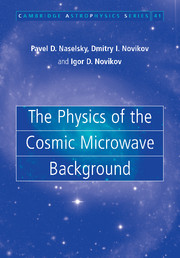Book contents
- Frontmatter
- Contents
- Preface to the Russian edition
- Preface to the English edition
- 1 Observational foundations of modern cosmology
- 2 Kinetics of electromagnetic radiation in a uniform Universe
- 3 The ionization history of the Universe
- 4 Primordial CMB and small perturbations of uniform cosmological model
- 5 Primary anisotropy of the cosmic microwave background
- 6 Primordial polarization of the cosmic microwave background
- 7 Statistical properties of random fields of anisotropy and polarization in the CMB
- 8 The Wilkinson Microwave Anisotropy Probe (WMAP)
- 9 The ‘Planckian era’ in the study of anisotropy and polarization of the CMB
- 10 Conclusion
- References
- Index
1 - Observational foundations of modern cosmology
Published online by Cambridge University Press: 18 August 2009
- Frontmatter
- Contents
- Preface to the Russian edition
- Preface to the English edition
- 1 Observational foundations of modern cosmology
- 2 Kinetics of electromagnetic radiation in a uniform Universe
- 3 The ionization history of the Universe
- 4 Primordial CMB and small perturbations of uniform cosmological model
- 5 Primary anisotropy of the cosmic microwave background
- 6 Primordial polarization of the cosmic microwave background
- 7 Statistical properties of random fields of anisotropy and polarization in the CMB
- 8 The Wilkinson Microwave Anisotropy Probe (WMAP)
- 9 The ‘Planckian era’ in the study of anisotropy and polarization of the CMB
- 10 Conclusion
- References
- Index
Summary
Introduction
In a way, the entire history of cosmology from Ptolemy and Aristotle to the present day can be divided into two stages: a period before and a period after the discovery of the cosmic microwave background (CMB). The first period was the subject of hundreds of volumes of literature; now it is not only an integral part of science, but also marks a step in the progress of mankind. The second stage started in 1965 when two American researchers, A. Penzias and R. Wilson published their famous article in the Astrophysical Journal, ‘A measurement of excess antenna temperature at 4080 Mc/s’ (Penzias and Wilson, 1965), in which they announced the discovery of a previously unknown background radio noise in the Universe. Another article, in the same issue of the Astrophysical Journal, preceded the one by Penzias and Wilson; this was by R. Dicke, P. J. E. Peebles, P. Roll and D. Wilkinson (Dicke et al., 1965) and discussed the preparation of a similar experiment at a different wavelength, but also interpreted the Penzias–Wilson results as confirming the predictions of the ‘hot universe’ theory. The radiation with a temperature close to 3 K discovered by Penzias and Wilson was described as the remnant of the hot plasma that existed at the very onset of expansion which then cooled down as a result of expansion.
- Type
- Chapter
- Information
- The Physics of the Cosmic Microwave Background , pp. 1 - 32Publisher: Cambridge University PressPrint publication year: 2006

